Do you have a question about the Siemens LOGO! Series and is the answer not in the manual?
Describes the diverse applications and solutions offered by LOGO! for various engineering tasks.
Lists the different voltage classes and versions of LOGO! Base Modules available.
Details the types of digital, analog, and communication expansion modules available for LOGO!.
Describes the functionalities and advantages of the LOGO! Text Display module.
Explains the available LOGO! communication modules like AS-Interface and EIB/KNX.
Provides essential rules and standards for safely installing and wiring LOGO! devices.
Highlights critical safety precautions and design considerations for installing LOGO! in enclosures.
Details the importance of functional and safety testing before commissioning to prevent hazards.
Explains how to set up LOGO! networks, including maximum connections and compatibility.
Provides step-by-step instructions for mounting and dismounting LOGO! Base Modules and expansion modules.
Covers essential guidelines and procedures for correctly wiring LOGO! Base Modules and their components.
Guides users through the initial startup process and explains the different operating states of LOGO!.
Introduces the process of creating circuit programs for LOGO! applications using the Base Module.
Describes the physical inputs and outputs available on LOGO! Base Modules and expansion modules.
Explains the concept of function blocks and their numbering for creating complex circuits in LOGO!.
Illustrates how to translate conventional circuit diagrams into LOGO! circuit programs using blocks and connectors.
Presents four fundamental principles for efficient operation and programming of LOGO! devices.
Provides a visual overview of the menu structures for LOGO! 0BA6 and 0BA7 devices.
Details the step-by-step process of creating, editing, and starting circuit programs directly on the LOGO! unit.
Defines constants and connectors (inputs, outputs, flags) used in LOGO! programming.
Lists and explains the fundamental logic operations (AND, OR, NAND, etc.) available in LOGO!.
Introduces special functions like timers, retentive functions, and parameter assignment options.
Provides a comprehensive list and overview of available special function blocks in LOGO!.
Explains how to create and use User-Defined Functions (UDFs) in LOGO!Soft Comfort V7.0.
Describes how to edit elements connected to UDF blocks on the LOGO! module itself.
Provides instructions on how to edit or change elements connected to the inputs of a UDF block.
Details the procedure for editing or changing elements connected to the outputs of a UDF block.
Explains how to edit the parameter settings for UDF blocks configured in LOGO!Soft Comfort.
Guides users on how to edit elements connected to the Data Log function block on the LOGO! module.
Provides important notes regarding data logging, buffer capacity, SD card storage, and new data log file creation.
Explains how to access and navigate the parameter assignment mode for configuring LOGO! settings.
Discusses the various parameters available for configuration, such as timer delay times and counter thresholds.
Guides users on how to select and navigate through the available parameters for editing.
Details the process of changing parameter values, including time parameters and timer cam settings.
Covers the configuration of default values for clock settings, display contrast, language, and start screens.
Lists the types of cards available for LOGO! 0BA6: Memory Card, Battery Card, Memory/Battery Card.
Explains the compatibility of older memory cards with newer LOGO! modules and vice versa.
Details compatibility of newer cards with older LOGO! modules and series limitations.
Discusses the transferability of circuit programs written for previous LOGO! versions to newer devices.
Explains the security function for copy protection of circuit programs on memory cards.
Guides users on how to assign a circuit program and copy protection function to a memory card.
Describes the steps to enable the security function for copy protection.
Provides instructions on how to correctly insert and remove memory, battery, and SD cards from LOGO! devices.
Details the manual and automatic methods for copying circuit programs from LOGO! to memory cards.
Explains how to copy circuit programs from memory cards back to LOGO! devices.
Compares LOGO!Soft Comfort to conventional engineering methods, highlighting advantages.
Describes the features and operating systems supported by the LOGO!Soft Comfort programming software.
Mentions the current version and where to find its functions and device compatibility.
Covers the procedures for connecting LOGO! devices to a PC using PC/PPI and USB cables.
Informs about the availability of sample applications on the Siemens LOGO! website.
Lists various sample applications for LOGO!, such as irrigation systems and conveyor controls.
Highlights the advantages of using LOGO!, including space saving and flexibility.
Provides general technical specifications including dimensions, weight, installation, and climatic conditions.
Details the permitted ambient temperature, relative humidity, and atmospheric pressure ranges.
Covers EMC behavior regarding noise emission, electrostatic discharge, and electromagnetic fields.
Lists compliance with IEC standards for clearance, creepage distance, and insulation strength.
Provides detailed technical specifications for LOGO! 230RC, 230RCo, and 230RCE models.
Describes how to create a short test program in LOGO! to measure program cycle time.
Explains the concept of program cycle time and how the inverted flag and threshold trigger indicate it.
Lists the advantages of LOGO! versions without a display, such as cost-effectiveness and space saving.
Explains the two methods for creating circuit programs for LOGO! devices without an operator panel.
Illustrates the menu structure for LOGO! Basic devices, covering main, programming, transfer, and setup menus.
Shows the navigation path for the main menu and accessing other submenus on LOGO! Basic.
Details the options available within the programming menu for editing, password management, and message configuration.
Outlines the configuration options available in the setup menu, including clock, LCD, language, and analog input settings.
Presents the menu structure for LOGO! TD devices, including differences between ES6/earlier and ES7 versions.
Illustrates the main menu navigation for LOGO! TD, covering setup, card operations, and network diagnostics.
Details the setup options for LOGO! TD, including clock, contrast, language, and network settings.
Explains the network configuration options for LOGO! 0BA7 devices, including IP address and mode settings.
Describes how to access diagnostic information such as firmware version and error logs on LOGO! 0BA7.
Lists the order numbers for various LOGO! Base Modules, digital, analog, and communication modules.
Provides order numbers for software, memory cards, power modules, and connection cables.
Describes the diverse applications and solutions offered by LOGO! for various engineering tasks.
Lists the different voltage classes and versions of LOGO! Base Modules available.
Details the types of digital, analog, and communication expansion modules available for LOGO!.
Describes the functionalities and advantages of the LOGO! Text Display module.
Explains the available LOGO! communication modules like AS-Interface and EIB/KNX.
Provides essential rules and standards for safely installing and wiring LOGO! devices.
Highlights critical safety precautions and design considerations for installing LOGO! in enclosures.
Details the importance of functional and safety testing before commissioning to prevent hazards.
Explains how to set up LOGO! networks, including maximum connections and compatibility.
Provides step-by-step instructions for mounting and dismounting LOGO! Base Modules and expansion modules.
Covers essential guidelines and procedures for correctly wiring LOGO! Base Modules and their components.
Guides users through the initial startup process and explains the different operating states of LOGO!.
Introduces the process of creating circuit programs for LOGO! applications using the Base Module.
Describes the physical inputs and outputs available on LOGO! Base Modules and expansion modules.
Explains the concept of function blocks and their numbering for creating complex circuits in LOGO!.
Illustrates how to translate conventional circuit diagrams into LOGO! circuit programs using blocks and connectors.
Presents four fundamental principles for efficient operation and programming of LOGO! devices.
Provides a visual overview of the menu structures for LOGO! 0BA6 and 0BA7 devices.
Details the step-by-step process of creating, editing, and starting circuit programs directly on the LOGO! unit.
Defines constants and connectors (inputs, outputs, flags) used in LOGO! programming.
Lists and explains the fundamental logic operations (AND, OR, NAND, etc.) available in LOGO!.
Introduces special functions like timers, retentive functions, and parameter assignment options.
Provides a comprehensive list and overview of available special function blocks in LOGO!.
Explains how to create and use User-Defined Functions (UDFs) in LOGO!Soft Comfort V7.0.
Describes how to edit elements connected to UDF blocks on the LOGO! module itself.
Provides instructions on how to edit or change elements connected to the inputs of a UDF block.
Details the procedure for editing or changing elements connected to the outputs of a UDF block.
Explains how to edit the parameter settings for UDF blocks configured in LOGO!Soft Comfort.
Guides users on how to edit elements connected to the Data Log function block on the LOGO! module.
Provides important notes regarding data logging, buffer capacity, SD card storage, and new data log file creation.
Explains how to access and navigate the parameter assignment mode for configuring LOGO! settings.
Discusses the various parameters available for configuration, such as timer delay times and counter thresholds.
Guides users on how to select and navigate through the available parameters for editing.
Details the process of changing parameter values, including time parameters and timer cam settings.
Covers the configuration of default values for clock settings, display contrast, language, and start screens.
Lists the types of cards available for LOGO! 0BA6: Memory Card, Battery Card, Memory/Battery Card.
Explains the compatibility of older memory cards with newer LOGO! modules and vice versa.
Details compatibility of newer cards with older LOGO! modules and series limitations.
Discusses the transferability of circuit programs written for previous LOGO! versions to newer devices.
Explains the security function for copy protection of circuit programs on memory cards.
Guides users on how to assign a circuit program and copy protection function to a memory card.
Describes the steps to enable the security function for copy protection.
Provides instructions on how to correctly insert and remove memory, battery, and SD cards from LOGO! devices.
Details the manual and automatic methods for copying circuit programs from LOGO! to memory cards.
Explains how to copy circuit programs from memory cards back to LOGO! devices.
Compares LOGO!Soft Comfort to conventional engineering methods, highlighting advantages.
Describes the features and operating systems supported by the LOGO!Soft Comfort programming software.
Mentions the current version and where to find its functions and device compatibility.
Covers the procedures for connecting LOGO! devices to a PC using PC/PPI and USB cables.
Informs about the availability of sample applications on the Siemens LOGO! website.
Lists various sample applications for LOGO!, such as irrigation systems and conveyor controls.
Highlights the advantages of using LOGO!, including space saving and flexibility.
Provides general technical specifications including dimensions, weight, installation, and climatic conditions.
Details the permitted ambient temperature, relative humidity, and atmospheric pressure ranges.
Covers EMC behavior regarding noise emission, electrostatic discharge, and electromagnetic fields.
Lists compliance with IEC standards for clearance, creepage distance, and insulation strength.
Provides detailed technical specifications for LOGO! 230RC, 230RCo, and 230RCE models.
Describes how to create a short test program in LOGO! to measure program cycle time.
Explains the concept of program cycle time and how the inverted flag and threshold trigger indicate it.
Lists the advantages of LOGO! versions without a display, such as cost-effectiveness and space saving.
Explains the two methods for creating circuit programs for LOGO! devices without an operator panel.
Illustrates the menu structure for LOGO! Basic devices, covering main, programming, transfer, and setup menus.
Shows the navigation path for the main menu and accessing other submenus on LOGO! Basic.
Details the options available within the programming menu for editing, password management, and message configuration.
Outlines the configuration options available in the setup menu, including clock, LCD, language, and analog input settings.
Presents the menu structure for LOGO! TD devices, including differences between ES6/earlier and ES7 versions.
Illustrates the main menu navigation for LOGO! TD, covering setup, card operations, and network diagnostics.
Details the setup options for LOGO! TD, including clock, contrast, language, and network settings.
Explains the network configuration options for LOGO! 0BA7 devices, including IP address and mode settings.
Describes how to access diagnostic information such as firmware version and error logs on LOGO! 0BA7.
Lists the order numbers for various LOGO! Base Modules, digital, analog, and communication modules.
Provides order numbers for software, memory cards, power modules, and connection cables.
| Mounting | DIN rail mounting |
|---|---|
| Protection Class | IP20 |
| Inputs | Digital and analog inputs |
| Programming | LOGO! Soft Comfort software |
| Display | LCD display with backlight |
| Communication | Ethernet |
| Memory | Internal memory for program and data |
| Dimensions | Varies depending on the model |
| Weight | Varies depending on the model |
| Operating Temperature | 0°C to 55°C |
| Storage Temperature | -25°C to 70°C |
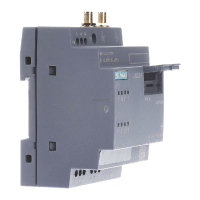


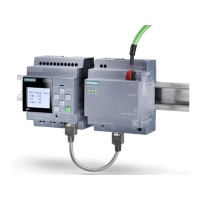
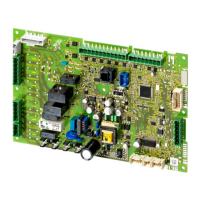
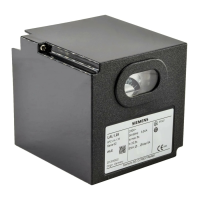


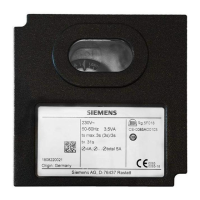
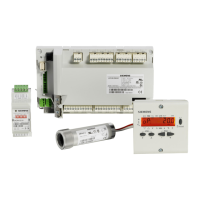


